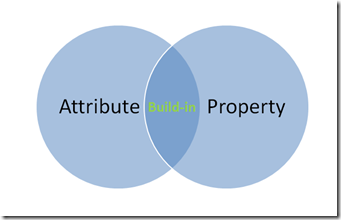在上篇據說每個大牛、小牛都應該有自己的庫——DOM處理最後剩下attr()和css()方法沒有處理,因為這兩個方法當時並不自計劃中,是寫著寫著突然想到的,一時間沒有特別好的思路,當時已十一點多了,就去睡了。沒想到啊沒想到接下來的一星期簡直是噩夢,每天加班回家都十一點,今天有時間趕緊補上。
property與attribute
之前說了這兩個方法是仿照jQuery的,看了一下jQuery的原始碼,發現從1.6後jQuery多了一個prop()方法,做的功能卻和attr()很相似,看了很多資料才明白prop是在解決什麼問題。
property和attribute都可以翻譯為屬性,不過為了區別一般把property翻譯為特性,而在JavaScript中,property和attribute的區別不止這麼簡單。setAttribute是為DOM節點設定/新增屬性的標準方法,我們一般會這麼用
var e = document.getElementById('ck'); e.setAttribute('title', 'test');
也可以這麼用
var e = document.getElementById('ck'); e.title = 'test';
無論怎麼設,在讀取的時候這麼用
alert(e.getAttribute('title'));
alert(e.title);
對attribute設定/讀取值使用setAttribute/getAttribute,property使用.操作符,兩種用法看似毫無區別,但是我們也經常設定元素的class,想要得到預期結果得這麼寫
e.setAttribute('class', 'test');
e.className = 'test';
同樣都是對class操作,使用attribute的key是class,property卻是className,其讀取的結果也不一定相同(input 的checkbox)
console.log(e.getAttribute('checked')); //checked
console.log(e.checked); //true
DOM物件大部分的內建property都有對應的名字的attribute(名字也可能不同,比如上面的class),對於自定義的屬性雙發互不干擾(IE9以下版本還是共享的)
e.setAttribute('customizeProperty', 'attribute');
e.customizeProperty = 'property';
console.log(e.getAttribute('customizeProperty')); //attribute
console.log(e.customizeProperty); //property
看起來似乎很清楚了,看個例子
<input id="ck" type="checkbox" checked="checked" /> <script type="text/javascript"> var e = document.getElementById('ck'); console.log(e.getAttribute('checked')); //checked console.log(e.checked); //true e.checked = false; console.log(e.getAttribute('checked')); //checked console.log(e.checked); //false e.setAttribute('checked', 'checked'); console.log(e.getAttribute('checked')); //checked console.log(e.checked); //false </script>
這是怎麼個情況,不是內建屬性是共享的嗎,怎麼互不干擾了?這是因為一些Boolean型別的屬性(如checked, selected, disabled等)比較特殊,其attribute只保留初始值(預設值), property才是當前最新的狀態值。一個預設勾選的checkbox,當在頁面去除勾選的時候,checked這個property已由true變為false,而checked這個attribute仍然保持“checked”這個初始值。
attr()
這都和attr()有神馬關係,說上面的原因是既然瞭解了property和attribute的不同,那麼自己的庫乾脆也像jQuery把property和attribute分開處理。自己寫了很多,總是有這樣那樣的問題,看到了大神John Resig的處理方法後,豁然開朗,這兩個方法是可以寫成結合體的,無恥的簡單改造了一下抄過來,註釋寫的都這麼經典沒捨得刪
attr: function (elem, name, value) { // Are we setting a value? if (typeof name == 'object') { for (n in name) { attr(elem, n, name[n]); } } else if (value !== undefined) { // Make sure the element has the ability to set an attribute if (typeof elem.setAttribute !== "undefined") { // If the user is setting the value to false if (value === false) { // Completely remove the attribute elem.removeAttribute(name); // Otherwise set the attribute value } else { // If the user is setting the value to true, // Set it equal to the name of the attribute // (handles boolean attributes nicely) elem.setAttribute(name, value === true ? name : value); } // If it doesn't, then we're likely dealing with window or document // (or some other object entirely) } else { elem[name] = value; } // Otherwise we're getting an attribute value // Check to see if the appropriate method exists // Also don't use getAttribute if a boolean property exists } else if (typeof elem.getAttribute !== "undefined" && typeof elem[name] !== "boolean") { return elem.getAttribute(name); // If no getAttribute method is present, or if we // wish to access the boolean property instead of the // attribute, then we fallback to the DOM object property } else { return elem[name]; } }
css()
css()方法就寫不了jQuery那麼強大了,基本沒有做錯誤處理,所以使用的時候必須保證傳入的屬性名稱和值是正確的,同時只能傳入簡單的屬性名,而不能是-moz-等類似的
css:function(ele,name,value){ if(typeof name=='object'){ for(n in name){ ssLib.css(ele,n,name[n]); } }else if(typeof value!='undefined'){ ele.style[_parseStyleName(name)]=value; }else{ return ele.style[_parseStyleName(name)]; } }
參考
http://ejohn.org/blog/jquery-16-and-attr/(大神John Resig的部落格)
